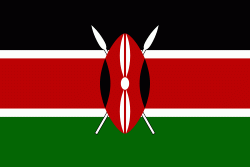Embu (Embu)
Embu is a city located approximately 125 km northeast of Nairobi towards Mount Kenya. Embu served as the provincial capital of the former Eastern Province and currently serves as the headquarters of the Eastern Region in Kenya. It is also the county headquarters of Embu County. Located on the south-eastern foothills of Mount Kenya, the Municipality of Embu had a population of 204,979 in 2019 census. Embu is also the 8th Largest Municipality in Kenya.Embu municipality has been ranked as the fastest growing municipality Outside municipalities within Nairobi.It is the commercial hub of the Central Eastern part of Kenya and provides an avenue for trade, tourism and highway transit between the national capital and the Northern Frontier.
Embu town is a major trading centre in Eastern Kenya. For a long time, it was the main economic centre for the Embu, Mbeere, Meru and Kamba communities as well as other communities from central Kenya. Mbeere was carved out of the former Embu district in the 1990s and Siakago town, about 25 km east of Embu town, was made its headquarters.
Origins of Embu people are cited from North West Africa. They moved south to Congo. Then they later moved Eastward to the coast of Kenya via Tanganyika. It is in Tanganyika that there were intermarriages with both natives and migrants from farther south (mostly Bantus). Due to many circumstances they moved North towards Meru leaving their relatives, the Gikuyu at Ithanga. They then crossed Igambang'ombe ford. They settled at Gikuuri near Maranga hills. They had come from Igembe and came to Tharaka where they also settled. They left Tharaka possibly due to famines and moved to the current Embu.
It is believed as they moved towards the slopes of Mt Kenya, they encountered pygmy tribes such as the Gumba and the Zimba in the forest; some of whom were cannibalistic. They are cultivators. They planted crops like sorghum, millet and sweet potatoes. Today they have cash crops like coffee, tea, miraa and macadamia, among others.
Embu town is a major trading centre in Eastern Kenya. For a long time, it was the main economic centre for the Embu, Mbeere, Meru and Kamba communities as well as other communities from central Kenya. Mbeere was carved out of the former Embu district in the 1990s and Siakago town, about 25 km east of Embu town, was made its headquarters.
Origins of Embu people are cited from North West Africa. They moved south to Congo. Then they later moved Eastward to the coast of Kenya via Tanganyika. It is in Tanganyika that there were intermarriages with both natives and migrants from farther south (mostly Bantus). Due to many circumstances they moved North towards Meru leaving their relatives, the Gikuyu at Ithanga. They then crossed Igambang'ombe ford. They settled at Gikuuri near Maranga hills. They had come from Igembe and came to Tharaka where they also settled. They left Tharaka possibly due to famines and moved to the current Embu.
It is believed as they moved towards the slopes of Mt Kenya, they encountered pygmy tribes such as the Gumba and the Zimba in the forest; some of whom were cannibalistic. They are cultivators. They planted crops like sorghum, millet and sweet potatoes. Today they have cash crops like coffee, tea, miraa and macadamia, among others.
Map - Embu (Embu)
Map
Country - Kenya
 |
 |
| Flag of Kenya | |
Kenya's earliest inhabitants were hunter-gatherers, like the present-day Hadza people. According to archaeological dating of associated artifacts and skeletal material, Cushitic speakers first settled in Kenya's lowlands between 3,200 and 1,300 BC, a phase known as the Lowland Savanna Pastoral Neolithic. Nilotic-speaking pastoralists (ancestral to Kenya's Nilotic speakers) began migrating from present-day South Sudan into Kenya around 500 BC. Bantu people settled at the coast and the interior between 250 BC and 500 AD. European contact began in 1500 AD with the Portuguese Empire, and effective colonisation of Kenya began in the 19th century during the European exploration of the interior. Modern-day Kenya emerged from a protectorate established by the British Empire in 1895 and the subsequent Kenya Colony, which began in 1920. Numerous disputes between the UK and the colony led to the Mau Mau revolution, which began in 1952, and the declaration of independence in 1963. After independence, Kenya remained a member of the Commonwealth of Nations. The current constitution was adopted in 2010 and replaced the 1963 independence constitution.
Currency / Language
| ISO | Currency | Symbol | Significant figures |
|---|---|---|---|
| KES | Kenyan shilling | Sh | 2 |
| ISO | Language |
|---|---|
| EN | English language |
| SW | Swahili language |















